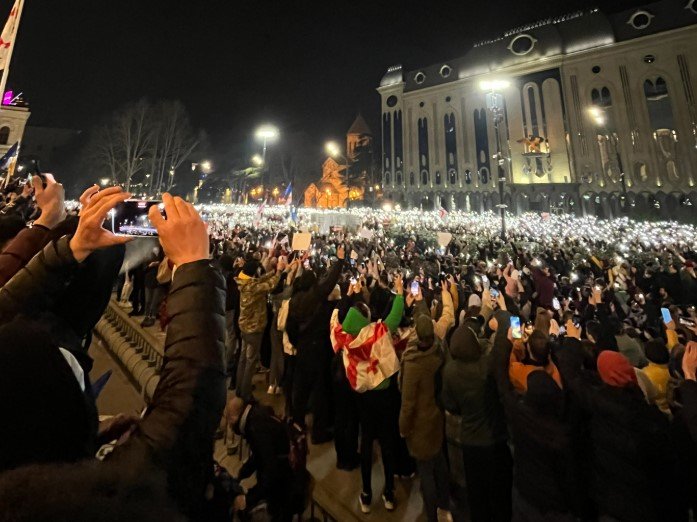The streets of Georgia have become the epicenter of a rapidly growing protest movement, with thousands rallying against government policies and perceived threats to the nation’s democratic future. Anger continues to mount following the ruling Georgian Dream party’s announcement to freeze EU accession talks until 2028, a move that has ignited outrage across political, social, and civil platforms.
A Crisis Deepens with Political and Social Divides
The political crisis gripping Georgia is not new but has reached a boiling point. Tensions flared after the disputed October 26 parliamentary elections, which opposition parties and much of civil society deemed fraudulent. President Salome Zurabishvili and several minority groups have echoed these concerns, demanding accountability and democratic reforms.
The government’s decision to pause EU accession talks has added fuel to the fire. What started as a protest against foreign policy has morphed into a larger resistance movement, uniting diverse sections of society. Demonstrators are calling for new elections and the release of detained activists, alleging police brutality and political oppression.
“It’s not just about the EU; it’s about our future, our rights, and our freedom,” said one protester at Rustaveli Avenue in Tbilisi, the symbolic heart of Georgia’s resistance.

A Coordinated Movement Across Cities
Protests are no longer confined to the capital. Nationwide demonstrations have taken hold, with coordinated rallies planned across key cities such as Tbilisi, Zugdidi, Batumi, and Kutaisi. Each city has become a hub of activity, with participants voicing their demands through creative and impactful means.
In Tbilisi, symbolic events like mask protests and gift distribution near the Parliament Christmas tree showcase the community’s resilience. Meanwhile, students, small entrepreneurs, and various civic groups have amplified their voices through organized marches and rallies.
In Zugdidi, a protest in front of the Regional Administration echoed anti-Russian sentiments, while Batumi’s demonstrators gathered outside the Constitutional Court to champion national sovereignty. Kutaisi, on the other hand, became a rallying point for pro-European slogans, emphasizing the divide between public aspirations and government decisions.
Timeline of the Resistance
The protest timeline reads like a playbook of determination:
- January 4: Demonstrators marked the 38th consecutive day of protests outside Parliament, blocking roads and demanding action.
- January 5: Nationwide demonstrations continued, with planned rallies in multiple cities emphasizing the unified nature of the resistance.
- January 6: The 40th day of protests saw heightened activity, with large gatherings near Kashueti Church on Rustaveli Avenue to celebrate Orthodox Christmas while maintaining the call for change.
These continuous protests underscore the people’s unwavering resolve, despite reports of police crackdowns and efforts to suppress live civil society broadcasts by Georgian Public Broadcaster (GPB).
Protest Demands and Government Stalemate
The resistance has coalesced around two primary demands:
- New parliamentary elections under a framework perceived as fair and transparent.
- The immediate release of individuals detained during the protests.
The government, led by Georgian Dream and its controversial presidential candidate Mikheil Kavelashvili, has largely ignored these demands. Critics argue this approach has only deepened public mistrust and widened the gap between citizens and their leaders.
International observers are keeping a close watch, with the European Union and other organizations expressing concern over democratic backsliding in Georgia.
Uniting a Nation
At its core, this movement is about more than politics. It represents a collective yearning for dignity, justice, and a brighter future. Georgians, from diverse ethnic and social backgrounds, have found common ground in their shared aspirations.
The protests have been marked by powerful moments of solidarity:
- Students from various universities rallying together to defend academic freedoms.
- Small business owners standing side by side with artists and laborers, highlighting the socioeconomic challenges facing the country.
- Religious and cultural celebrations intertwined with protest events, creating a uniquely Georgian expression of resistance.
One participant remarked, “We are showing the world that our voice matters, that we won’t back down.”
What Lies Ahead
As the protests show no signs of waning, questions linger about the government’s next move. Will the Georgian Dream party bow to public pressure, or will it double down on its current course? For now, the streets remain filled with voices of dissent, a testament to the resilience of a nation at a crossroads.
